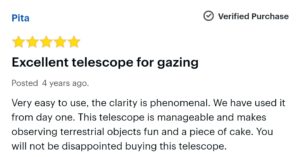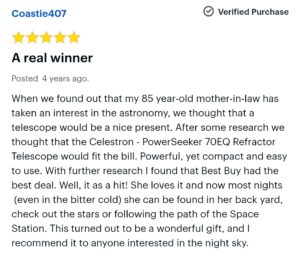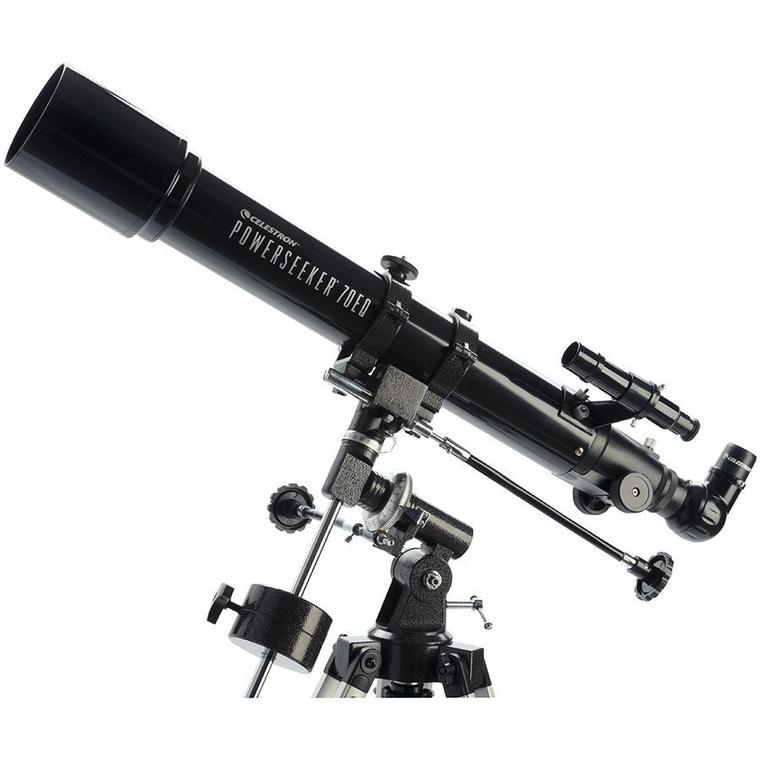*This post may contain affiliate links. This means we may make a commission if you purchase an item using one of our links*
Welcome to my Celestron PowerSeeker 70EQ Review!
In this review I’ll cover the pros, cons and the 70EQ’s features to ultimately help you decide on whether the system is worth investing in or a beginner level device that you should skip out on.
Overview
Table of Contents
- Full Name: Celestron PowerSeeker 70EQ
- Type: Refractor
- Aperture: 70mm (2.76″)
- Focal length: 700mm
- Focal ratio: f/10
- Dimensions & Weight: 95.2 x 32 x 23.4 centimetres & 4.7kg
- Included eyepieces: 20mm kellner and a 4mm Ramsden
- Rating: 4/5
Pros
- Low maintenance
- A good number of accessories included
- A solid mount
- Lightweight and portable
Cons
- A little expensive for the specs
- Subpar finderscope
- PERFECT ENTRY-LEVEL TELESCOPE: The Celestron PowerSeeker 70EQ is an easy-to-use and powerful telescope. This 70mm refractor telescope offers enough light gathering ability to see planets, the Moon's craters, distant stars, the Orion Nebula, and more.
- MANUAL GERMAN EQUATORIAL MOUNT: With its slow-motion altitude rod, the German Equatorial mount allows you to navigate the sky with ease. Find celestial objects quickly and follow them smoothly & accurately as they appear to drift across the night sky.
- COMPACT AND PORTABLE: The ideal telescope for adults and kids to use together, the PowerSeeker is compact, lightweight, and portable. Take it to your favorite campsite, a dark sky observing site, or simply the backyard.
- MULTIPLE ACCESSORIES: The Celestron PowerSeeker 70EQ Telescope comes with 2 quality eyepieces (20mm and 4mm) plus a 3x Barlow lens to triple the power of each. You'll also receive a FREE download of one of the top-rated astronomy software programs.
- UNBEATABLE WARRANTY & SUPPORT: Buy with confidence from Celestron, a leading telescope brand in California since 1960. Your purchase includes a 2-Year US Warranty and unlimited support from our team of US-based experts.
How Do The Celestron PowerSeeker 70EQ’s Optics Work?
The PowerSeeker line utilises mostly refractor based optics for their telescopes and the 70EQ certainly isn’t any different here.
Refractor optics tend to also come 2 main sub variations namely Apochromatic and achromatic, with the later being the lesser quality of the two and of course also the type of lens used within the 70EQ.
Refractor optics are also the oldest of the 3 main optical categories (the other 2 being reflector and compound optics) but, they are still solid particularly for smaller more compact telescopes.
With that being said, they do have their fair share of pros and cons which is what I’ll briefly list out for you below.
The Pros of the optics within the 70EQ include the following :
- Because refractor devices always use enclosed tubes, it also means that the optics within won’t need to be cleaned or collimated all the time
- The lens allows the device to double as a spotting scope for viewing things on Earth along with extraterrestrial objects in outer space.
- The images will generally be sharper because misalignment isn’t very common with the refractor lens found within.
As for the cons, they are the following :
- As the refractor lenses are thicker, it results in the achromatic lens to suffer from chromatic aberration therefore, certain lights i.e. ultraviolet light won’t be accurately captured. (this can be minimised if the focal ratio is high enough)
- Refractor optics also tend to be more expensive than a similarly powered reflector counterpart
- The other 2 optical variations are also a lot better at viewing faint objects in space
The 70EQ’s optics for the most part are great for what they are however, considering the price of the devices and of course the size of the lens, they’re far from the best.
What Do The Celestron PowerSeeker 70EQ’s Specifications Mean?
The 70EQ has an aperture of 70mm (2.76″), a focal length of 700mm resulting in a fairly narrow focal ratio of f/10. This means that the device shouldn’t suffer from chromatic aberration as much and that it should technically be better for planetary viewing.
The theoretical max magnification of the device should also be around 165x although real world usage will decrease that number by at least another 10-20%.
What this means is that if you’re able to get a good amount of power out of 70EQ you should technically be able to see the following celestial objects :
- The moon and its craters in reasonable detail
- Jupiter in reasonable detail
- Saturn and an outline of its rings near max power
- Mars, Mercury and Venus should be visible although not in much detail
- You should be able to make out some star clusters, a few galaxies as bright dots and maybe some asteroids if you’re able to track them and if they’re near enough to you.
Of course as a whole the device is very limited when it comes to performance but, considering its spotting scope like capabilities as well, at the very least you should also be able to check out objects on earth too if that’s something you fancy doing.
Now regarding the weight and dimensions of the 70EQ, its weight comes in at 4.7kg when fully assembled whilst the dimensions are very portable too coming in at 95.2 x 32 x 23.4 centimetres. So, if you’re looking for a solid portable beginner level telescope, the 70EQ isn’t a bad shout.
Accessories Included In The Box
The accessories that come included in the box are 2 1.25″ eyepieces one being a 20mm kellner and the other a 4mm Ramsden, a very subpar 5 x 24 finderscope, a 3x Barlow lens, an EQ-1 equitorial mount, an amici prism star diagonal pointer and a bunch of other miscellaneous documents.
The accessories provided are actually the weakest point about the 70EQ in my research. The eyepieces are too small for one where the magnification for the 20mm is a bit to high for the lower magnifications at 35x whilst the 4mm is too powerful for the device and won’t even be usable as it magnifies well beyond the telescopes upper limit at 175x.
The Barlow lens is very cheaply made too, although this is to be expected considering the 70EQ’s pricing. The finderscope is also pretty useless and will make the alignment process a pain whilst the amici star diagonal is quite subpar too as not only will it result in some intense diffraction among certain celestial objects but, the light it captures is also very dim.
The EQ-1 mount is probably the best inbox accessory as it does appear to work reasonably smoothly but, it’s also not the greatest of mounts for astrophotography related activities and does have minor issue with the clutches which is designed in a way that will put friction on the bearings.
What Are Users Of The Celestron PowerSeeker 70EQ Saying
For the most part the reviews from users are fairly positive so that’s definitely a good thing about the device.



Other Alternatives Worth Checking Out
If your still interested in telescopes under the $300 range, this list of ours will show a few other decent alternatives. If on the other hand your only interested in Refractor systems, this list of ours may prove helpful too.
Summary
The 70EQ is a decent entry level refractor device that should prove to be competent at viewing a fair few things whilst also being very portable and manageable at the same time.
Of course it has its limitations and won’t necessarily be the greatest if you want to make astronomy a long term hobby. Nevertheless, if you’re in the market for an entry level refractor device, for around $150 the 70EQ is not too bad a device.


